Hyacinth: description and varieties, planting and care
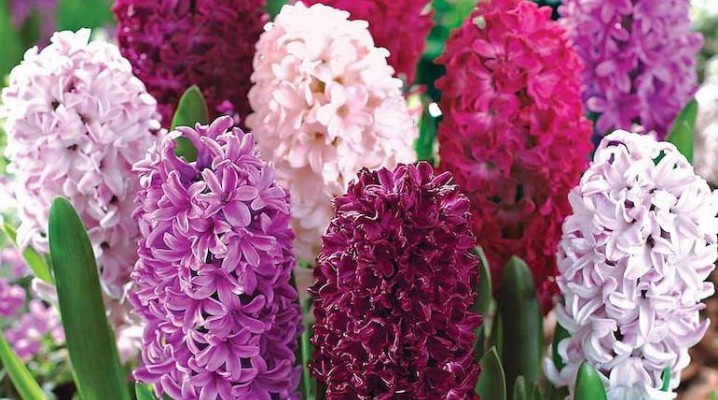
Hyacinth is a popular garden plant that can be found everywhere. There are a large number of varieties and varieties of hyacinth, which have different structural features and shades. What are the rules for caring for a plant, how to plant hyacinths when they bloom? Look for answers to these and other questions in this article.
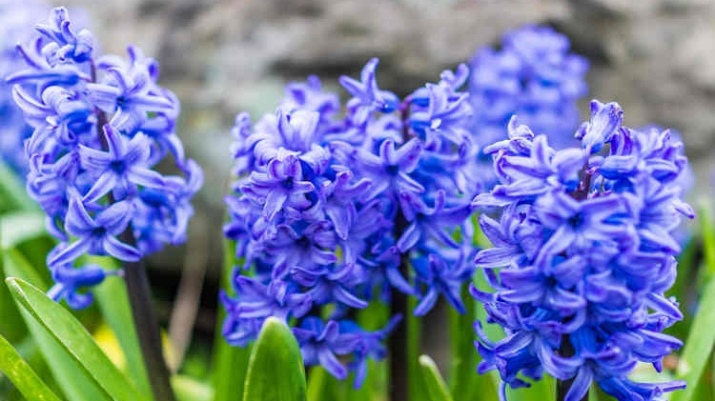
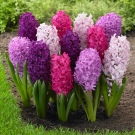


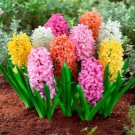
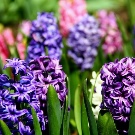
Peculiarities
Hyacinth is a perennial bulbous flower. He looks very beautiful both on his own and in a bouquet. It should be noted right away that there are no annual hyacinths. Its bulb is quite dense in structure, it is formed by special fleshy lower leaves. The perennial stem is flowering.
Hyacinth root is non-poisonous. After the flowering period ends, the flowering stem and leaves that are located on it dry out. At the same time, a bud is formed in the corner of the uppermost green leaf, which gradually grows, turning into a bulb, which will bloom the next year.
Hyacinth flowers are grouped at the top of the stem in the form of a brush. Their perianth has the shape of a bell-shaped funnel. The hyacinth fruit is a capsule that consists of 3 nests with seeds.
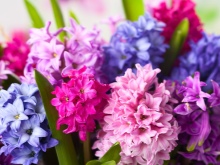

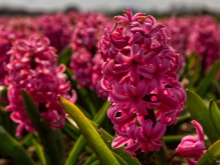
Types and varieties, their shades
Today, botanists have several dozen varieties of hyacinths. So, in nature you can find purple, lilac, blue, white, yellow, blue, pink, black, as well as oriental, field, wild, forest and many other species. In our article, we will look at several of the most popular species and varieties.
- "Jean Bose" (or "Jan Bose") - light-loving bright red flower that can reach 30 centimeters in length.
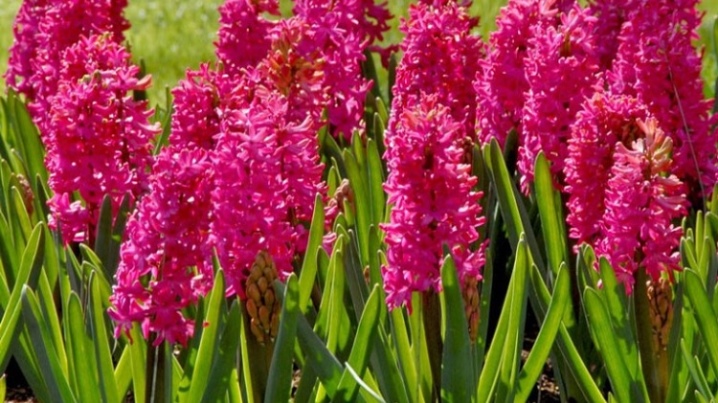
- Woodstock - garden large-flowered plant of a purple hue.
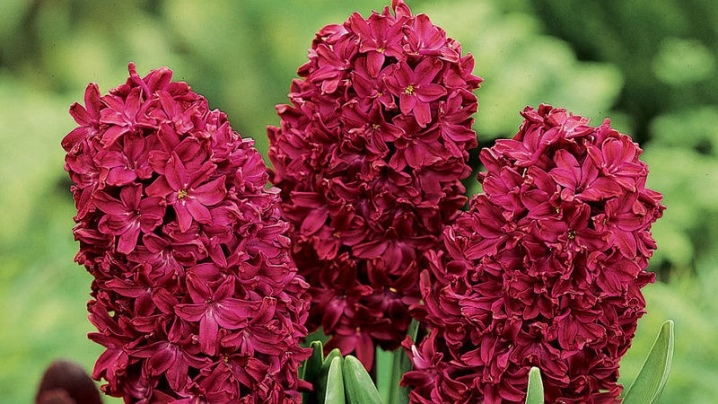
- "Gypsy Queen" - orange plant with a low level of winter hardiness.
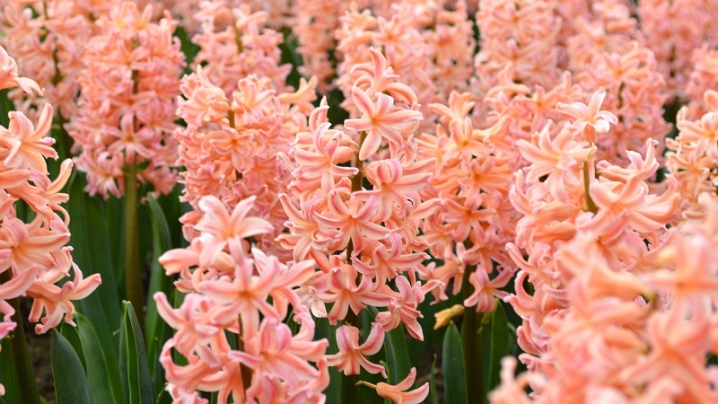
- "Gypsy Princesses". This yellow hyacinth blooms in spring.
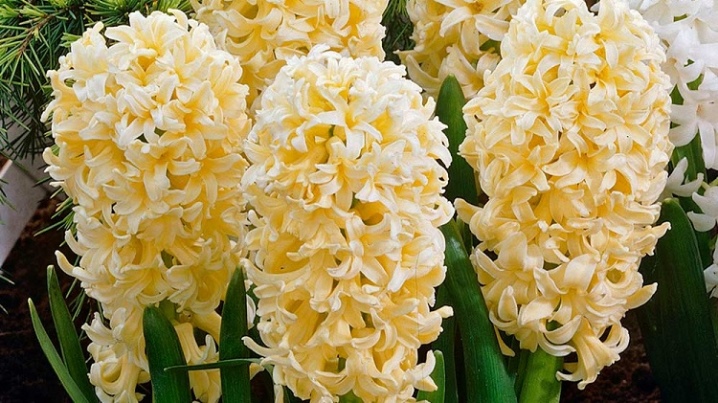
- "Anna Lisa" - a purple plant that grows up to 20 centimeters in height.

- "Pink Pearl" - a pink flower often used to decorate flower gardens.

- "Delft Blue" (or "Delft Blue") - a plant of a beautiful blue hue, popular all over the world.
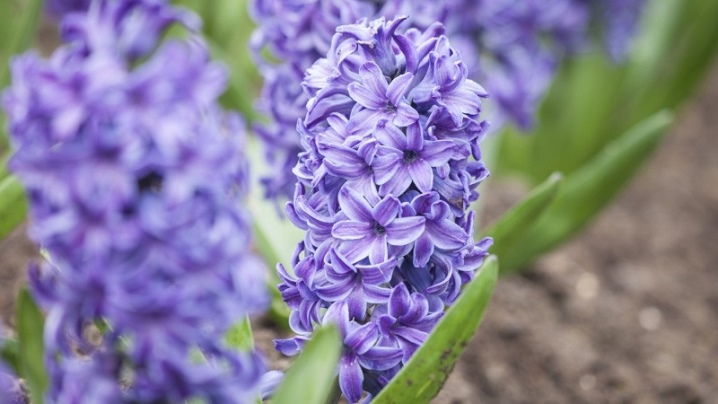
- Miss Saigon Is a pink-lilac hyacinth that blooms in April.
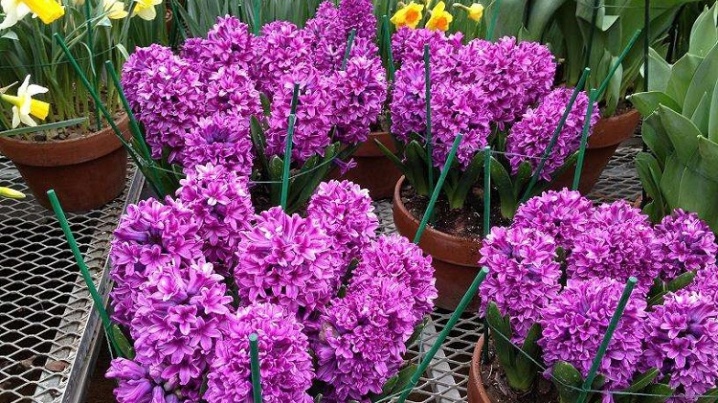
- City of Harlem - a plant with yellow flowers, which is planted in October or November.

- "Splendid Cornelia" - one of the most famous varieties of pink-lilac shade.
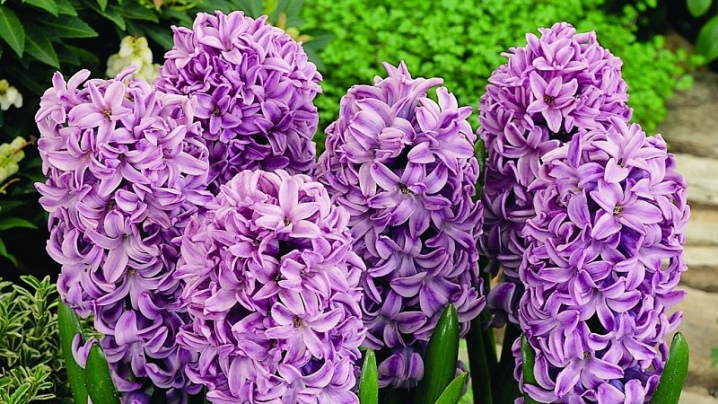
- "Wurbak" - red hyacinth with a strong aroma.
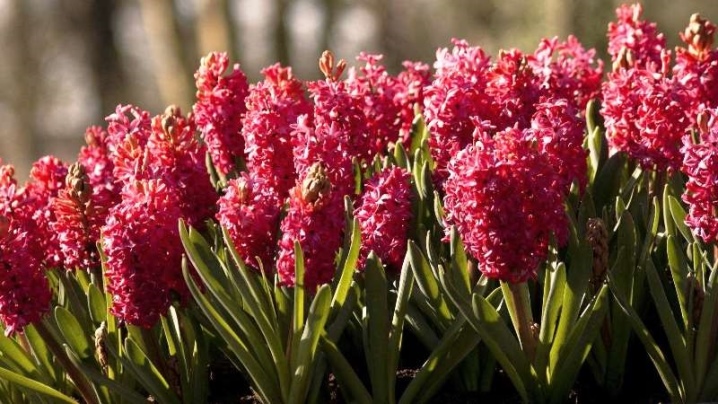
- "Blue Jacket" Is an early flowering variety with blue flowers.

Thus, you and I were able to make sure that there are many color variations of hyacinths... Therefore, each gardener can choose the variety that will suit his specific preferences.


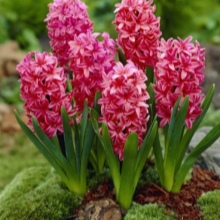
Flowering period
The flowering time of hyacinth is not strictly defined. It can be varied and depends on a number of characteristics:
- conditions of detention;
- landing period;
- watering;
- fertilization;
- temperature conditions, etc.
The flowering period can be in spring, winter, autumn or summer. Duration of flowering reaches 45-60 days.
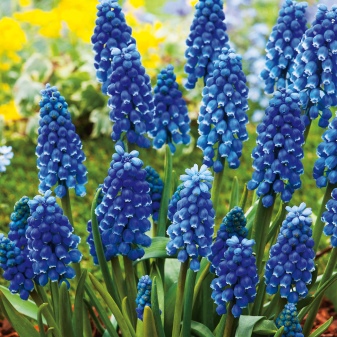
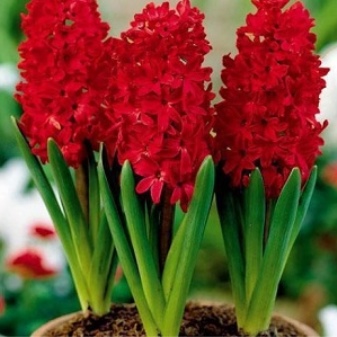
Choosing a place
In order for the hyacinths you have planted to actively grow and develop, you first need to find the optimal place for planting them.So, the site must receive a sufficient amount of daylight, but at the same time it must also be protected from wind and drafts. If you believe the recommendations of experienced gardeners, then the best place to plant hyacinths will be an area next to other shrubs and trees. Nevertheless, it is worth making sure that even such a site fully meets all the requirements.
It is desirable that the landing site be flat, but had a slight bias... Such characteristics will ensure the runoff of excess liquid (which is especially important in spring, when the snow melts, and during periods of heavy autumn rains). Remember that excess moisture in the soil where hyacinth grows can lead to various negative consequences, up to the death of its bulbs. If the area where you plan to plant the hyacinth is close to groundwater, then it is important to ensure that they are at least 0.5 meters deep.
It will also be useful to drain or equip the so-called bulk ridges.
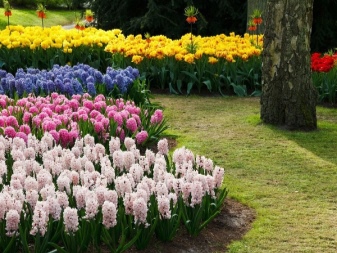
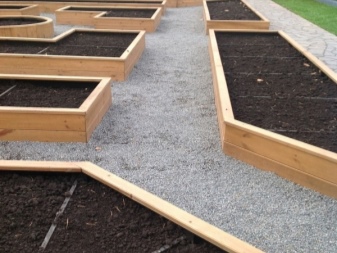
Growing conditions
If you decide to grow hyacinths at home or in the country, then you should familiarize yourself with all the rules that must be followed in the process of growing them. Hyacinths have special requirements for lighting, ambient temperature and soil.
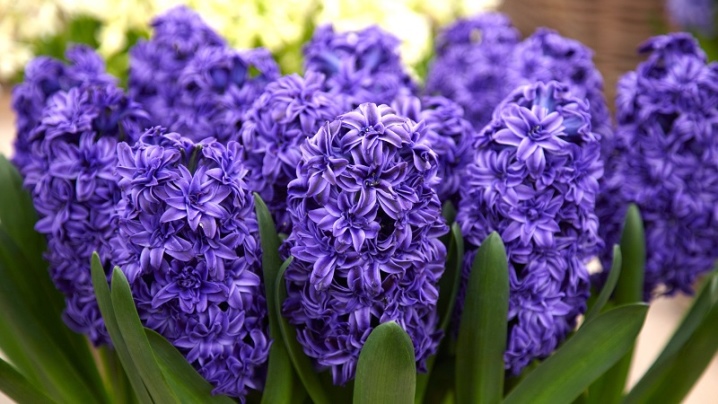
Lighting
Hyacinth belongs to light-loving plants. However, it must be borne in mind that during some periods (for example, during the growing season) the flower should be kept in the shade. For example, freshly planted bulbs should be kept in the dark for 6-8 weeks. After this, there is a gradual and slow increase in the amount of light. In the same time the flower should be protected from direct sunlight.
70 days after disembarkation, it is allowed to take out the hyacinth in partial shade. After the buds appear and develop, the hyacinth is taken out for several hours a day in a brightly lit place.
After flowering, it is also important to ensure that the plant is placed in an area out of direct sunlight.
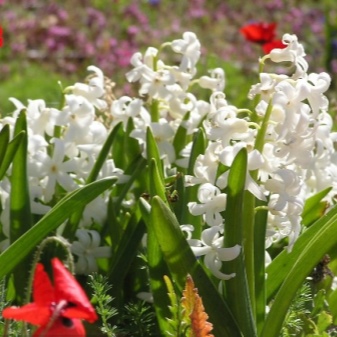

Temperature
In order for the plant to enter the flowering stage, it is necessary to arrange for it the so-called cool stratification. Plant bulbs should be stored at a temperature of about +5 degrees Celsius. Under such conditions, they are stored until sprouts appear. After that, the flower can be transferred to a warmer place.
When the shoots of the plant reach a height of 2 centimeters, the flower can be transferred to a room where the temperature approaches 10-12 degrees Celsius. After the flower arrow is ejected, hyacinth can be kept at room temperature.
Thus, we can conclude that hyacinth grows better in cool conditions than in heat. An increase in temperature can lead to all sorts of negative consequences, including the formation of an ugly loose inflorescence.
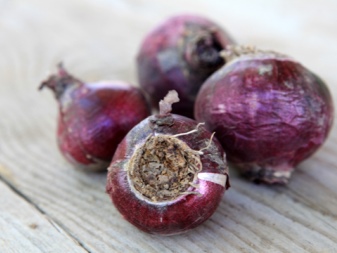
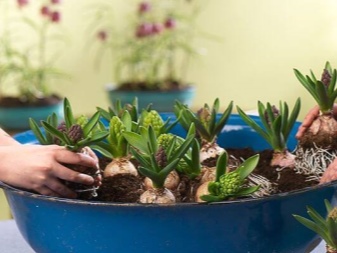
Soil requirements
Hyacinths are plants that require good quality soil. The soil must be water-permeable and contain a sufficient amount of nutrients. At the same time, it must be remembered that fresh or poorly decomposed manure is not recommended to be added to the soil for hyacinths.
If the area where the flowers grow is clay soil, then it is absolutely recommended to add river sand and peat to it. Acidic soils will negatively affect the growth and development of the plant. In order to avoid possible negative consequences, they must be limed with chalk.
The minimum allowed pH level is 6.5 units.
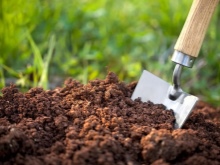

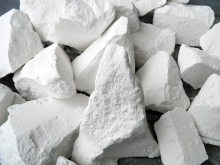
How to plant?
Planting hyacinths in the ground is usually carried out no earlier than October. But before planting the plants, it is important to take care of the preliminary preparation of the soil. All preparatory activities should be carried out 2 months before direct planting, that is, in August.If this requirement is neglected, then the natural sediment of the soil can provoke a rupture of the plant root.
The soil for hyacinths must be cultivated to a depth of at least 40 centimeters. Under the digging, such components as humus or manure, which have perepil, are introduced into the soil. These substances are introduced in a ratio of 10-15 kilograms per 1 square meter. Also, peat and mineral fertilizers (at the rate of 60-80 grams per 1 square meter), superphosphate, potassium sulfate (can be exchanged for wood ash) and magnesium (can be exchanged for dolomite flour) must be added to the ground.
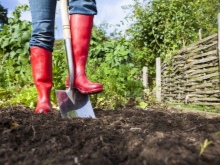
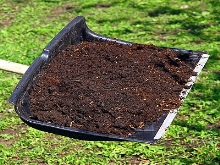

If you picked up a sandy patch of soil for planting hyacinths, then it needs to be saturated with potash and magnesium fertilizers 1.5 times more than it should be. Also, in the process of plant development (in early autumn), it is recommended to introduce nitrogen mixtures into the soil in the form of top dressing.
Some gardeners, when planting hyacinths, recommend choosing medium-sized bulbs, while rejecting too large or too small specimens.... Each bulb is recommended to be buried 15 centimeters into the ground. At the same time, a little river sand should be poured onto the bottom of the hole (the total thickness of the layer should not exceed 5 centimeters). It is recommended to lightly press the onion into the sand, cover it with a small amount of the same sand on top, and then cover it with the prepared soil mixture. This procedure prevents rotting of the bottom of the bulbs, and also protects the plant from all kinds of infections and improves drainage.
If you follow all the planting rules, then very soon a purple, pink or white flower bed will appear in your garden, which will attract the attention of all neighbors and passers-by, as well as delight household members.
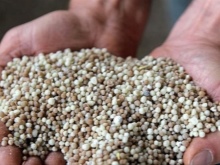
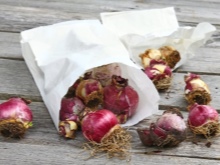
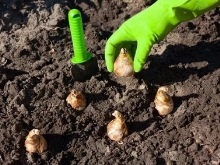
How to care?
In order to grow hyacinths at home on your own, it is important to follow the recommendations of specialists and the rules of agricultural technology.
Watering
When planting flowers, you should make sure that the soil is sufficiently moist, but at the same time not damp. In this case, the soil must be watered abundantly enough (so that the top layer is wet). Allow the soil to dry out between waterings. Hyacinths need an increased amount of moisture during flowering. When the plant has bloomed, the intensity of watering can be reduced, but at the same time, it is necessary to continue to observe their regularity.
After the leaves of the flower die off, watering should be completely stopped. At this point, the bulbs must be kept in completely dry soil. If you are keeping hyacinths in a pot, you can water them using a drip tray.
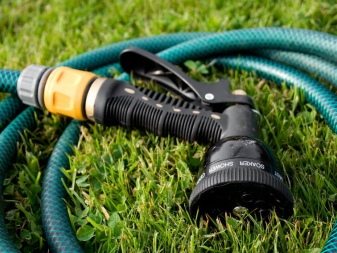
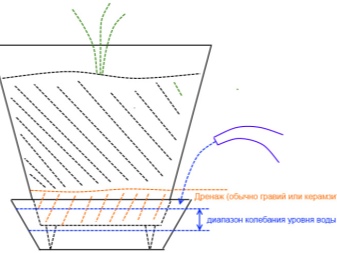
Top dressing
For feeding hyacinths, you can use dry or liquid (dissolved in water) feeding. If you prefer to apply the former, then before the direct feeding process, it is necessary to moisten the soil well.
For the first time, it is recommended to add fertilizers at the very beginning of flower growth. In this case, it is recommended to use 20-25 grams of nitrate and 15-20 grams of superphosphate per 1 square meter of planting. The next feeding should be carried out at the time of bud formation, it should consist of 30-35 grams of superphosphate and 15-20 grams of potassium sulfate. The third top dressing usually occurs at the end of flowering, this time 30-35 grams of superphosphate and 30-35 grams of potassium sulfate are added.
In addition, hyacinths can be fertilized with so-called micronutrients, after the introduction of which it is imperative to loosen the soil.
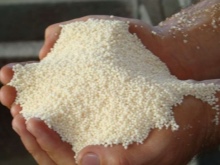

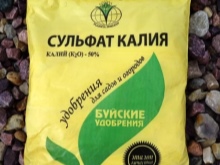
Transfer
Hyacinth can be transplanted for distillation at any time. For this, the bottom of the container must be covered with a layer of drainage. Then several bulbs are placed in it. It is important to place them in such a way that they protrude from the ground. The soil around the bulb needs to be tamped a little.
When transplanting, it is important to maintain a distance between plants of at least 2.5 centimeters. River sand most often acts as the top layer, which helps the soil to get rid of excess moisture.The transplanted hyacinths must be kept in a cool and darkened room in a cramped pot until a new sprout appears.
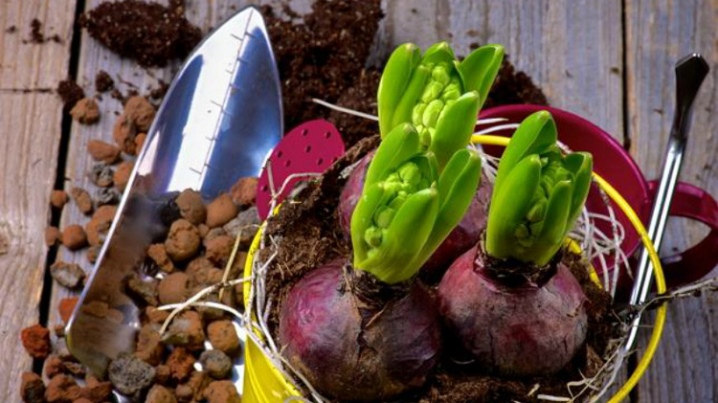
Distillation
To grow hyacinths for distillation, they must be grown in containers the size of which is not less than 9x9x10 centimeters... In standard pots with a diameter of 12-25 centimeters, you can plant 3 plants. At the same time, it is recommended not to plant plants nearby if they belong to different varieties.
If there are babies on the maternal root, then they must be separated, because they will take stocks of nutrients from the bulbs. It is recommended to deepen the plant by 2/3 of the height. It is important that under any conditions the top of the plant remains on the surface - this will protect the flower from rotting.
Further, the hyacinth must be watered with a 0.2% solution of calcium nitrate, which will help strengthen the peduncles. To grow, the plant must be in a dark place at a temperature of +9 degrees Celsius. In this case, it is very important to ensure that the substrate does not dry out.
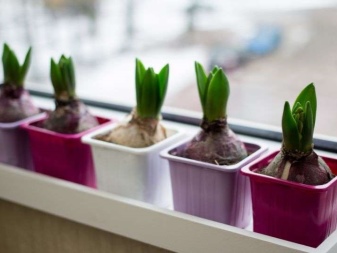

If in the room where the plant is kept, the humidity level is at the level of 90-95%, then for the whole winter you will need to water only 1 (subject to late distillation). With early distillation, the plant can do without watering altogether.
Inspect the leaf cone to determine how ready the plant is for placement. If the extension of the leaf cone is at least 10 centimeters, and the inflorescence can be felt at the base, the plant is ready.

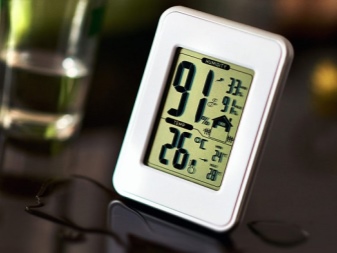
Reproduction methods
If for you the main task of breeding hyacinths is to breed new species and varieties, then in this case it is recommended to use the seed method. In order to propagate hyacinth with seeds, it is necessary to sow them in the fall (optimally at the end of September). Seeds are sown in prepared containers with soil. In this case, the soil mixture should consist of humus, leafy earth and sand (ideal proportions - 2: 1: 1).
Newly grown flowers will not look like their parents in appearance. In this case, one should take into account the fact that they will bloom only after 5 years. For the first few years, the sown seeds are recommended to be grown in a cold greenhouse.
It is also important to note the fact that hyacinths can reproduce naturally without any human intervention. However, this reproduction is rather slow. Each year, one adult can produce 1 or 2 daughter bulbs (“babies”). If such daughter bulbs are easily detached from the mother, then they can be grown separately as independent plants. Otherwise, daughter individuals grow together with mothers.
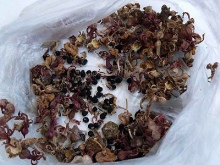
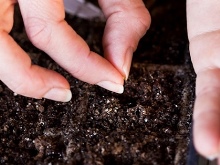

If we talk about the cultivation of hyacinths on a large scale (for example, in industrial horticulture), then it should be noted that in this case, the method of natural reproduction is not applied. In industrial conditions, artificial methods are used. This is done in order to speed up the breeding process and, accordingly, increase the number of new bulbs obtained.
It should also be borne in mind that before proceeding with the cultivation of hyacinths artificially, it is necessary to take care of the preliminary processing of the bulbs. Most often for these purposes they use 1% solution of potassium permanganate.
After such a chemical treatment, the bulbs must be dried within 48 hours at a temperature not lower than +20 degrees.

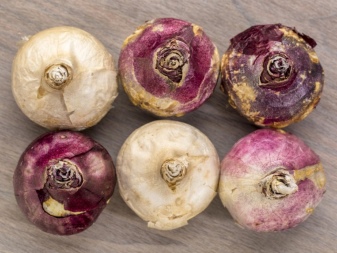
Storing the bulbs
The storage time of hyacinth bulbs is considered one of the most critical periods. First of all, this is due to the fact that it is at this moment that the most important processes associated with the formation of inflorescences take place inside the bulb. Depending on at what stage of inflorescence formation the bulb is located, the environmental conditions required for it also change.
Hyacinths have very high temperature requirements. So, right after you dug out the hyacinth bulbs, they must be carefully and thoroughly dried. This procedure is recommended for at least 5 days at a temperature of +20 degrees. For drying, it is best to use a darkened, but at the same time well and regularly ventilated area. The bulbs themselves need to be cleaned of soil and roots, and also grouped according to the size of each specimen.
The peeled and sorted onions should be carefully placed in the boxes. However, it should be remembered that they must not be stacked in more than 2 layers... When carrying out this process, it is also not recommended to separate the small daughter onions. If there are not too many of them, then ordinary paper bags can be used instead of storage boxes. For convenience, they can be signed or numbered.
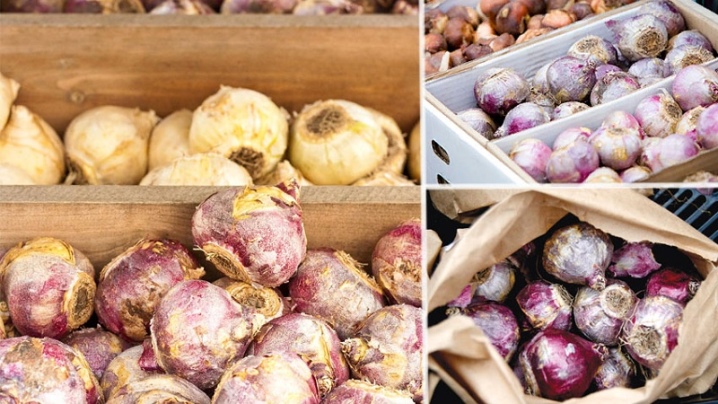
The very procedure for storing hyacinth bulbs consists of 2 main stages. The first involves storing bulbs at elevated temperatures, and the second is often called pre-planting. The first stage of storage should last at least 2 months and take place in a strictly defined temperature regime - at + 25-26 degrees. The pre-planting stage lasts 2 times less (only 30 days) and is carried out at +17 degrees. It is also important to observe the optimal humidity indicators, because too dry air can lead to irreversible consequences.
In order to shorten the duration of these stages, the temperature at which the bulbs are stored should be increased. So, in order to shorten the first stage by 7 days, the storage temperature should be increased to +30 degrees in the first week.
Thus, the total storage time for the bulbs should be approximately 95 days. At the same time, before planting the plant directly, it is recommended to keep the bulbs in cooler conditions, which will be as close as possible to the outside air temperature.
In order to plant hyacinths in open soil in early December, you need to dig up the bulbs themselves in July.
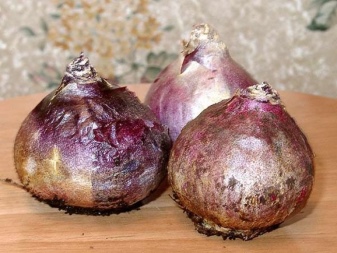
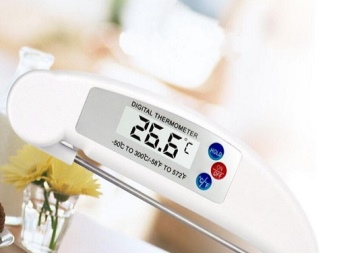
It should be borne in mind that during storage, hyacinth bulbs can form a large number of "daughters". In their structure, the latter are very fragile and therefore easily break. It is in this regard that during the disembarkation process, it is especially necessary to handle such specimens with particular care.
In order to properly plant the mother bulb together with the daughter ones, you need to halve the depth of the plant holes. In addition, it is imperative to carry out the mulching procedure. Moreover, the layer of mulch should be thick and dense enough. Daughter bulbs will grow for at least 4 years.
If you yourself want to cause the formation of such daughter bulbs, then immediately after you dig up the mother bulbs, wipe their bottom and carefully remove all the remnants of the roots.
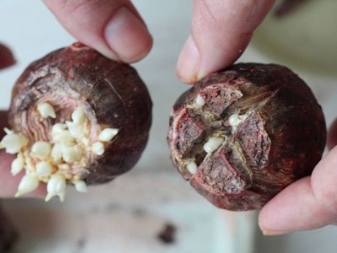
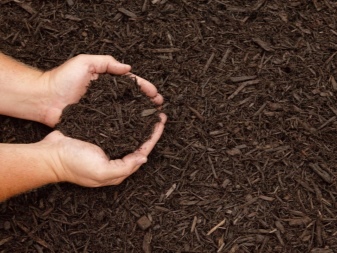
Diseases and pests
In the event that plants grow in open ground conditions, hyacinths are little affected by such negative factors as diseases and pests. On the other hand, there is a high likelihood of infestation of flowers in the greenhouse and forcing. In addition, there are a number of risk factors that most commonly lead to diseases of hyacinths. Among them are the following points.
- Purchase of contaminated feedstock. In order to avoid this, it is important to purchase plants only from trusted sellers who have a good reputation and are trusted by a large number of buyers. In addition, it is important to carefully check the material upon purchase. If you are a beginner in gardening, then you can use the advice of a specialist.
- Landing in the wrong ground. Planting is the most important process on which the further growth and development of flowers depends. Therefore, in no case can one ignore the recommendations of specialists, on the contrary - they must be strictly adhered to, avoiding the slightest deviations.It is forbidden to plant hyacinths in those areas where other bulbous or root crops previously grew.
- Improper feeding. There are a number of substances that are contraindicated to be used as fertilizer for hyacinths. These include fresh manure.
- Planting all bulbs. During the growing season, after digging, during storage, as well as before direct planting, it is imperative to make a so-called sample of bulbs, rejecting all low-quality material.
- Ignoring preventive measures. Carrying out preventive measures is an obligatory part of plant care. Preventive measures that should be taken with hyacinths include, for example, dressing of the bulbs.
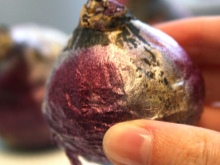

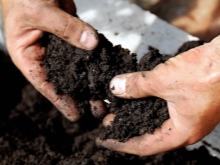
In the event that you find that hyacinths have begun to lag behind in growth performance, their peduncles have an unnatural defective shape, yellowing or fading areas have appeared, it is necessary to immediately start treating the plant from pests. If the disease affects only a few flowers from a large population, it is recommended that the affected plants be immediately dug up and destroyed. The rest of the healthy hyacinths need to be treated with phosphorus preparations.
One of the most popular ailments that most commonly affects hyacinths is yellow bacterial rot... Its effect on the plant is that the flower begins to die due to the formation of a thick layer of mucus on the bulb, which has a pungent and unpleasant odor. This mucus gradually destroys the plant bulb.
In addition, you may encounter such a common phenomenon as loss of hyacinth inflorescences... This is due to the fact that the pressure in the root system of the plant increases significantly. Most often, this phenomenon is associated with excessive watering, planting too early or storing the bulbs in inappropriate conditions. If you have encountered a rare disease of hyacinths and do not know what to do, it is best to dig up an infected flower so that the disease does not spread to healthy shoots.

Advice
Hyacinths can be used to decorate areas in landscaping. You can create independent compositions from them (for example, combining flowers of different shades) or supplement with other colors. Hyacinths will be an excellent addition to the flower bed, decorate the gazebo around the perimeter. They can also be dropped off at the entrance to the house or along the paths.
Such bright plants will delight you and cheer you up.


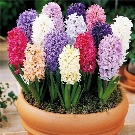

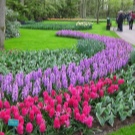

In the next video, you will find the rules for planting hyacinth bulbs.







































































































The comment was sent successfully.